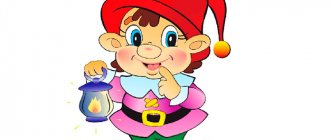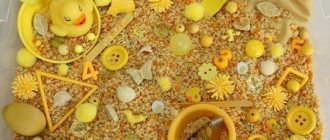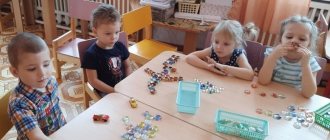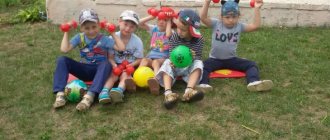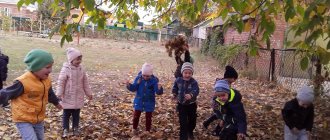Do not snooze
Children stand in a circle (there will be a round dance). For a round dance, you need to choose a song in which the same word will be repeated repeatedly, for example, the song “Clouds are white-maned horses.” Before the round dance begins, the leader explains the rule: after hearing a certain word, for example, the word “clouds,” the guys should clap their hands loudly (you can choose another action, for example, stomp, squat, and so on). The song begins, and with it the round dance. Whoever was “gazey” and did not perform the action when the word was sounded is eliminated from the game and receives a consolation prize. And the winners receive applause and gifts.
Edible pyramid
At this age, children really love to build things. But I’m already tired of simple pyramids and construction sets. Therefore, we can offer the children a non-standard version of “construction”. Each participant is given the same number of bagels, for example, 10 pieces. At the command of the leader, the children begin to build a pyramid of bagels. Here you will have to try, show persistence and caution. Whoever builds the pyramid first wins the main prize. The rest of the participants will also not be left without gifts, because for diligent efforts and painstaking work (building a pyramid out of bagels is not so easy at this age) there is a prize.
How to organize children's games at home using entertaining materials
- Small children are very restless. The child's attention can be focused on one thing for a very short time. The game should last 10-15 minutes, otherwise the baby will lose interest in it.
- Don't start playing a few hours before bed or before eating. The child will play out and will not be able to sleep.
- Games must be planned in advance. Prepare all the necessary items. Buy everything you need: glue, colored paper, cardboard, glitter, etc.
- If you use ready-made sets for games, do not give these toys to children for constant use. After play, fold and put away toys.
- Don't force your child to follow the instructions in the game. Consider the characteristics of your baby. Don't rush and don't force your child to learn more than he can handle.
- Cultivate neatness and a love of cleanliness. The only note: do not yell at the child, do not blame him for being sloppy. The best thing you can do to develop certain qualities in your child is to be an example.
- You can play one on one with children. But it will be more effective to teach in a playful style if children of different ages participate. A child of two years and a child of 4 years. Younger people repeat after older people more readily. Even if children of the same age do something together, they will no longer be bored.
- Keep track of the size of the items you use in the game. Small objects may be swallowed or inhaled by a child. Children aged 2-3 years really like to taste everything.
Cones for a bear
Children are divided into teams of approximately 5 participants. At the same distance from each team, cones, nuts and chestnuts are scattered in the same quantity, for example, 10 pieces. Team members stand behind each other in separate rows. The first participants are given a basket. At the “start” command, the first participants run to their pile with “fruits” and take only one (but you need to choose quickly and correctly). And according to the rules of the game, you only need to collect cones. As soon as the first participant took the cone, he puts it in his basket and runs to his team, passing the basket to the second participant. The team that collects all the pine cones for the bear the fastest will win.
Naughty socks
Children are divided into teams of approximately 5 participants. For each team, you need to prepare sets of socks in advance (5 pairs per team, if there are 5 participants in the team). Each participant on each team is given one sock from the team kit. The second socks are placed in a pile at the same distance from each team. At the command “start”, the participants run one by one to their pile, look for their sock, run back and put two socks on their feet. After the first participant has found his sock, the second participant goes in search, followed by the third, and so on. The team whose children will quickly find their socks and put them on their feet will win.
Games with a child in quarantine to develop tactile memory
Where is it ringing?
For the game we will need:
- Three cardboard boxes.
- Bell.
- Groats.
- Colored paper.
Take three boxes, preferably the same size. Cover these boxes with colored paper. Place a bell inside the boxes, in another cereal, and leave the third empty. Shake the boxes and listen to the sounds the boxes make. Ask your child to guess what's inside the box.
Make the task more difficult. Ask your child to indicate the color of the box the items are in. Game time 10 minutes. After playing, put the boxes away. Next time, you will be able to play this game in a couple of days.
Help mom and dad with the housework.
Very often, parents complain about their grown-up children that they do not help with the housework. They don’t clean their room and don’t want to participate in the household chores. This happens because in childhood it is easier for mothers to sit their child in front of cartoons and quickly do all the housework than to spend a long time cleaning the apartment together with the baby. To involve your child in the game, you can hide small surprises in different parts of the room.
For example, place a chocolate egg among scattered toys. The child will collect toys and find a gift.
Do as I do.
Sit opposite your child and show emotions by commenting on your actions. Smile and say, “I’m happy now.” Next time, frown and say, “I’m angry right now.” After some time, ask your child to show you his emotions.
Don't get confused!
For the game we will need:
- Balls or plastic balls of different colors.
- Colored paper of different colors.
The essence of the game is that you place colored balls and pieces of paper on the floor. Take turns picking up the balls and calling out the colors. “This ball is green, and this ball is red.” Ask your child to place the balls on the corresponding pieces of paper.
The game should last no more than 10 minutes, otherwise the child will lose interest in it.
Find the cube.
For the game we need plastic cubes of different colors.
Place the cubes in places accessible to the child (on the table, on the sofa, on the nightstand). Offer to build a tower. If you find that the cubes are not there, be surprised and ask your child to find them. Comment on the baby’s actions: “What a great fellow you are!” I found a red cube on the table.”
Be sure to pay attention to the color of the cube you find and name the place where it was lying. The game promotes the development of auditory perception, teaches you to distinguish colors
.
Color the circles.
To play we will need:
- Four sheets of paper.
- Two colored pencils.
Take two sheets of paper and draw a large circle on each of them. Invite your child to play: let him color his circle yellow, and you color it red. When looking at the drawings, draw the child’s attention to the color of the circle, draw analogies: “How beautifully you painted the circle yellow, now it looks like the sun.”
On the other two sheets, draw large squares or triangles as desired. Color them by switching pencils. Discuss what the figure looks like. In the future, you can involve other family members in the game, dad and grandmother of older children, not forgetting to draw the child’s attention to the number of figures and pencils.
Do not insist that your child paints the figures strictly along the outline. Be sure to participate in the game, looking at you, the child will repeat your actions and acquire useful skills. The game promotes the development of motor skills, imitative activities, and teaches to distinguish colors.
Let's figure it out!
To play we will need:
- 3 circles cut out of cardboard.
- 3 squares of cardboard.
Mix circles and squares. Ask your child to help you select all the circles. Then paint them one color. To color the squares, use pencils of a different color. The game helps develop classification skills.
For compote and salad
The guys are divided into teams with the same number of participants, for example, 5. For each team, piles of fruits are located at the same distance (the sets for all teams are the same, for example, tomato, cucumber, radish, onion, pepper, plum, apricot, strawberry, raspberry , pear. Of course, you can take fake fruits and vegetables, but toy or special fruits for decoration. Near each pile there are 2 baskets with inscriptions and pictures: on one basket there is a picture with a jar of compote, and on the second basket there is a picture with a bowl of salad. At the command “start”, the first team members run to their pile of fruits and choose one fruit for one and the other basket, that is, one fruit for compote and one fruit for salad. As soon as the choice is made, the participants run back to their team and pass the baton to the second participants.The team in which the guys correctly distribute the vegetables and fruits into the appropriate baskets will win.
Development of fine motor skills in a two-year-old child
Such different paper.
To play you will need:
- album sheet;
- notebook sheet;
- a sheet of colored paper;
- napkin.
Crumple the sheets of paper one by one and involve your child in this activity. Comment: “Here is a paper napkin. Look how easily it wrinkles, because it is made of very thin and soft paper.”
Now let's try to remove the notebook paper. Look, it’s harder to remove, it’s dense.” You can roll the crumpled sheets into balls and play snowballs with them. In the game, the child gets acquainted with the properties of materials and develops fine motor skills.
Grasp with tweezers.
To play you will need:
- tweezers;
- paper balls;
- cotton balls;
- pieces of foam rubber;
- large beads.
Purpose and actions:
- Teach your child to use tweezers. Show how you can take cotton balls, small pieces of foam rubber, and beads.
- Make the game more difficult by replacing soft objects with hard buttons, screws, cereal beans, and so on. You can use paper torn into small pieces.
- Invite your child to sort objects of two types: cotton wool and beans. In the future, the game can be complicated, soft and hard objects, light and heavy round and square, and so on.
The game promotes the development of fine motor skills.
We sort the pasta.
To play you will need different types of pasta, shells, feathers, vermicelli, and horns.
Show your child what types of pasta there are: “This is a shell, this is a spiral, this is a bow, this is vermicelli.” Mix them, ask the child to sort the pasta: shells to shells, bows to bows, and so on.
Help your child cope with this difficult task. The game promotes the development of fine motor skills and classification skills.
Try unfastening it.
To play you will need: adult clothes that fasten with buttons, zippers, and Velcro. Show your child how to fasten and unfasten buttons. How a zipper works, how to unfasten clothes with Velcro.
After the baby learns to do this, move on to things with smaller buttons, then ask the baby to fasten and unfasten the buttons on his own clothes. The game promotes the development of fine motor skills and independence skills.
Past again!
To play you will need:
- cereals, such as buckwheat or rice;
- two containers with a wide hole and a narrow hole;
- plastic bottle with cap.
After the child has learned to pour cereal into a wide-necked container, make the task more difficult by allowing the child to use a container with a narrowed top. Let the baby try to pour the cereal into small plastic jars and bottles.
With the lids screwed on, they turn into rattles. Draw the child’s attention to the degree of filling: “This jar is half full, and there is almost no empty space left in this bottle.” The game promotes the development of fine motor skills and coordination.
Button patterns.
This game can be played with all family members.
You will need 20 pieces of different buttons, with or without stems, in different colors, sizes, formats.
Lay out a path of large buttons with your child. During the game, name the color and shape of each button. Soon the child will remember that all buttons are round and learn to classify objects according to one criterion.
In the future, the game will involve buttons of different sizes, do not forget to compare them: “Now we take a smaller button, look how it differs from the large one, and now let’s put the smallest button.”
From buttons you can lay out patterns, flowers, houses, in a word, everything that your imagination tells you when asking your child what he would like to lay out from buttons which buttons he will play with today and which ones tomorrow. The game promotes the development of fine motor skills and awakens the child's creativity.
